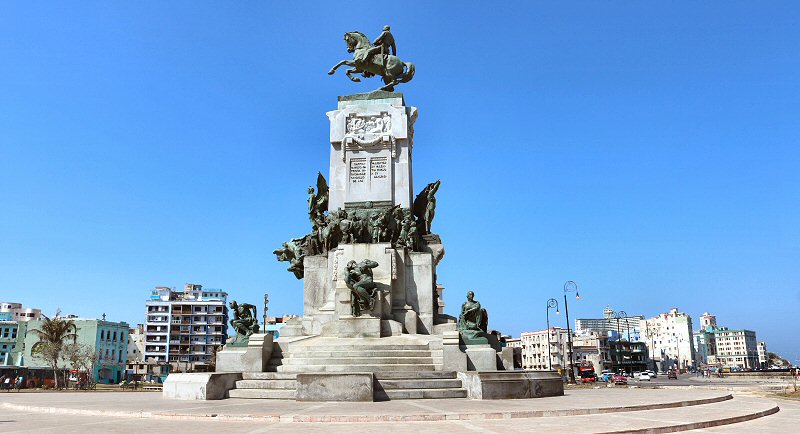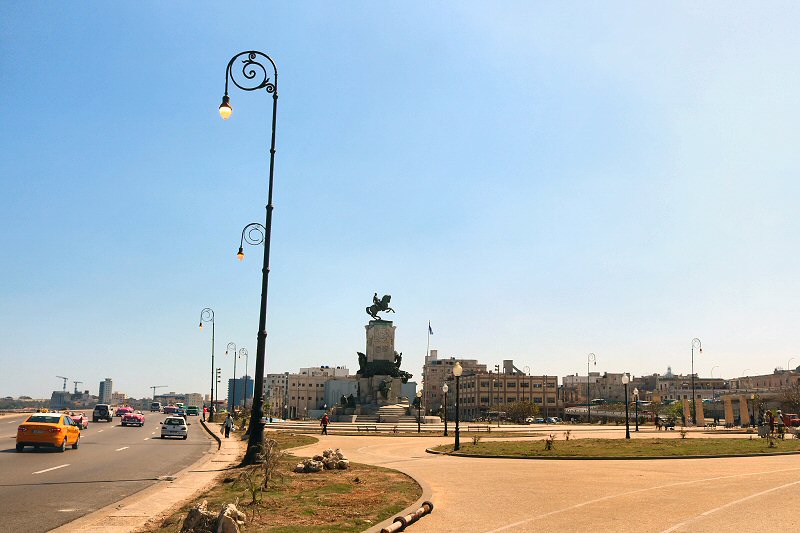

The Parque Antonio Maceo is located
along the Malecón, in an area, bordered by the San Lazaro,
Marina and the Padre Varela (former Belascoaín) streets.
The area, in that the Monument of
Antonio Maceo stands today, was a desolate beach along the
Caleta de Juan Guillén (current cove of San Lázaro) until
the Torreón de San Lázaro was built here in 1665. Torreón
means a large tower, built for the defense of a
fortification or a square. Towards the end of the 17th
century, patients, particularly the leper patients, were
treated in some huts in this extramural area. Thus, during
the period of 1744 and 1760 the Real Hospital de San Lázaro
was built and subsequently, in 1781 the leprosium was
completed in this region. Even though, the building of the
Real Hospital invigorated the life around the San Lázaro
street, the area was still a deserted urban fragment on the
transition between the old and new expanding city. Thus, in 1806 the
first public cemetery of Cuba, the Cementerio de Espada, was
inaugurated close to the Torreón de San Lázaro, bordered by
the Aramburu, the Vapor and the San Lázaro streets. For a
long time, the land, embracing the cove of San Lázaro,
stayed a section of the city that was not preferred as the
residential area. Not only the Cementerio de Espada, but
also the the Batería de la Reina (or Batería de San Lázaro)
that was built during the period 1856 and 1861, played a
great role in this hesitation. The Batería de San Lázaro that occupied
a circular large square with 44 cannons and a garrison of
about 250 soldiers, was designed to protect the shore
outside of the Havana Bay by a crossfire with the Batería de
Santa Clara that was built in the place of the current Hotel
Nacional de Cuba.
When the Batería de San Lázaro was
demolished at the beginning of the 20th century, its area
stayed abandoned for a while. In the meantime, the idea to
open a park, dedicated to Antonia Maceo, one of the leaders
of the Cuban Liberation Army, was added to the agenda of the
government, so that in 1911 a contest was held by inviting
prestigious sculptures and architects. 26 projects were
presented. The commission entrusted the Italian sculptor to
make the sculpture of Antonio Maceo and the architect
Francisco Centurion to design the park around the monument.
The monument of Antonio Maceo was unveiled in 1916, but the place around the monument that was conceived to be a park, stayed abandoned for years. The Real Hospital de San Lázaro was demolished in 1916, so that the soulless square around the monument continued to be surrounded by the Torreón de San Lázaro, the Casa de Beneficencia (House of Beneficence), the Ministry of Health and Welfare, and the Manhattan Hotel. The indifference of the rulers in building a park around the monument of the hero, led to great protests. Finally, when Carlos Miguel de Céspedes that would have great urban works in Havana in the future, was assigned as Secretary of Public Works, the Parque Antonio Maceo could be inaugurated in 1925. However, objections went on incessantly, as everybody wished to build a park that would deserve the name of Antonio Maceo, a park that would befit the dignity of Havana. Thus, several modifications were done in the park until 1960s, when its area was increased to 30.000 m2 and a tunnel that connected the park with the wall of the pier was built. In 1996, on the occasion of the centenary of the death of the Major General in the fight, the lighting system of the park was revised, a flagpole was erected close to the monument, the deteriorated pavement was renewed, new seats were installed and new vegetation was planted. The park underwent the last restoration in 2018.

